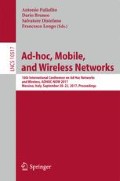Abstract
In this paper, we investigate the problem of deploying 3D nodes in a wireless sensor network. The aim is to choose the ideal 3D locations to add new nodes to an initial configuration of nodes, while optimizing a set of objectives. In this regard, our study proposes a new hybrid algorithm which stems from the ant foraging behavior and the genetics. It is based on a recent variant of the genetic algorithms (NSGA-III) and the Ant Colony Optimization algorithm. The obtained numerical results and the simulations compared with experiments prove the effectiveness of the proposed approach.
Access this chapter
Tax calculation will be finalised at checkout
Purchases are for personal use only
References
Van den Bossche, A., Dalce, R., Val, T.: OpenWiNo: an open hardware and software framework for fast-prototyping in the IoT. In: Proceedings 23rd International Conference on Telecommunications, Thessaloniki, Greece, pp. 1–6, 16–18 May 2016. doi:10.1109/ICT.2016.7500490
Cheng, X., Du, D.Z., Wang, L., Xu, B.: Relay sensor placement in wireless sensor networks. ACM/Springer J. Wirel. Netw. 14(3), 347–355 (2007). doi:10.1007/s11276-006-0724-8
Deb, K., Jain, H.: An evolutionary many-objective optimization algorithm using reference-point-based nondominated sorting approach, part I: solving problems with box constraints. IEEE Trans. Evol. Comput. 18(4), 577–601 (2013). doi:10.1109/TEVC.2013.2281535
Dorigo, M., Maniezzo, V., Colorni, A.: Ant system: optimization by a colony of cooperating agents. IEEE Trans. Syst. Man Cybern. Part B (Cybern.) 26(1), 29–41 (1996). doi:10.1109/3477.484436
Aval, K.J., Abd Razak, S.: A review on the implementation of multiobjective algorithms in wireless sensor network. World Appl. Sci. J. 19(6), 772–779. ISSN 1818-4952 (2012). doi:10.5829/idosi.wasj.2012.19.06.1398
Mnasri, S., Nasri, N., Val, T.: An overview of the deployment paradigms in the wireless sensor networks. In: Proceedings International Conference on Performance Evaluation and Modeling in Wired and Wireless Networks, Tunisie, 04–07 November 2014
Qu, Y.: Wireless sensor network deployment. Ph.D. dissertation, Florida International University, Miami, Florida, USA (2013)
Matsuo, S., Sun, W., Shibata, N., Kitani, T., Ito, M.: BalloonNet: a deploying method for a three-dimensional wireless network surrounding a building. In: Proceedings of the Eighth International Conference on Broadband and Wireless Computing, Communication and Applications, pp. 120–127 (2013). doi:10.1109/BWCCA.2013.28
Jiang, J.A., Wan, J.J., Zheng, X.Y., Chen, C.P., Lee, C.H., Su, L.K., Huang, W.C.: A novel weather information-based optimization algorithm for thermal sensor placement in smart grid. IEEE Trans. Smart Grid 99, 1–11 (2016). doi:10.1109/TSG.2016.2571220
Sweidan, H.I., Havens, T.C.: Coverage optimization in a terrain-aware wireless sensor network. In: Proceedings of the 2016 IEEE Congress on Evolutionary Computation, Vancouver, BC, pp. 3687–3694 (2016). doi:10.1109/CEC.2016.7744256
Deb, K., Pratap, A., Agarwal, S., Meyarivan, T.: A fast and elitist multiobjective genetic algorithm: NSGA-II. IEEE Trans. Evol. Comput. 6(2), 182–197 (2002). doi:10.1109/4235.996017
Zhang, Q., Li, H.: MOEA/D: a multiobjective evolutionary algorithm based on de-composition. IEEE Trans. Evol. Comput. 11(6), 712–731 (2007). doi:10.1109/TEVC.2007.892759
Ibrahim, A., Rahnamayan, S., Martin, M.V., Deb, K.: EliteNSGA-III: an improved evolutionary many-objective optimization algorithm. In: Proceedings IEEE Congress on Evolutionary Computation, Vancouver, BC, Canada, pp. 973–982, 24–29 July 2016. doi:10.1109/CEC.2016.7743895
Sim, K.M., Sun, W.H.: Ant colony optimization for routing and load-balancing: survey and new directions. IEEE Trans. Syst. Man Cybern. Part A: Syst. Humans 33(5), 560–572 (2003). doi:10.1109/TSMCA.2003.817391
Shen, H.: A study of welding robot path planning application based on Genetic Ant Colony Hybrid Algorithm. In: Proceedings IEEE Advanced Information Management, Communicates, Electronic and Automation Control Conference, Xi’an, China, pp. 1743–1746, 3–5 October 2016. doi:10.1109/IMCEC.2016.7867517
Huang, P., Chen, J.: Improved CCN routing based on the combination of genetic algorithm and ant colony optimization. In: Proceedings 3rd International Conference on Computer Science and Network Technology, Dalian, China, pp. 846–849, 12–13 October 2013. doi:10.1109/ICCSNT.2013.6967238
While, L., Hingston, P., Barone, L., Huband, S.: A faster algorithm for calculating hypervolume. IEEE Trans. Evol. Comput. 10(1), 29–38 (2006). doi:10.1109/TEVC.2005.851275
The OMNeT platform (2016). https://omnetpp.org/omnetpp. Accessed 9 June 2016
The jMetal platform (2015). http://jmetal.sourceforge.net/. Accessed 2 Mar 2015
The Arduino platform (2017). https://www.arduino.cc/en/main/software. Accessed 5 Jan 2017
Farhad, A., Farid, S., Zia, Y., Hussain, F.B.: A delay mitigation dynamic scheduling algorithm for the IEEE 802.15.4 based WPANs. In: Proceedings International Conference on Industrial Informatics and Computer Systems, Sharjah, UAE, pp. 1–5, 13–15 March 2016. doi:10.1109/ICCSII.2016.7462430
Author information
Authors and Affiliations
Corresponding author
Editor information
Editors and Affiliations
Rights and permissions
Copyright information
© 2017 Springer International Publishing AG
About this paper
Cite this paper
Mnasri, S., Nasri, N., Van Den Bossche, A., Val, T. (2017). A Hybrid Ant-Genetic Algorithm to Solve a Real Deployment Problem: A Case Study with Experimental Validation. In: Puliafito, A., Bruneo, D., Distefano, S., Longo, F. (eds) Ad-hoc, Mobile, and Wireless Networks. ADHOC-NOW 2017. Lecture Notes in Computer Science(), vol 10517. Springer, Cham. https://doi.org/10.1007/978-3-319-67910-5_30
Download citation
DOI: https://doi.org/10.1007/978-3-319-67910-5_30
Published:
Publisher Name: Springer, Cham
Print ISBN: 978-3-319-67909-9
Online ISBN: 978-3-319-67910-5
eBook Packages: Computer ScienceComputer Science (R0)

